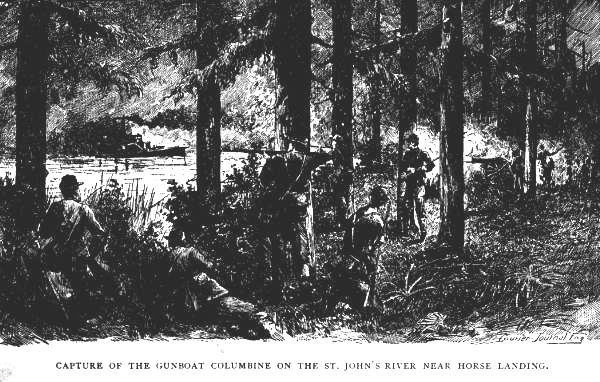Name USS Columbine Acquired 12 December 1862 Fate sunk, 23 May 1864 Length 36 m | Laid down date unknown Out of service 23 May 1864 Launched 1850 | |
 | ||
Type side-wheel steamer originally built as a tugboat | ||
USS Columbine (1862) was a side-wheel steamer that patrolled with the South Atlantic Blockading Squadron in the American Civil War.
Contents
- Commissioning
- Assigned to the South Atlantic Blockade
- Battle of Horse Landing
- Columbine captured by Confederate cavalry and burned
- Aftermath
- References
On 22 May 1864, Columbine was planning a raid on Confederate supplies at St. Augustine, Florida, when local cavalry commander Captain John Jackson Dickison, alerted by Confederate spy Lola Sánchez, ambushed the vessel at Horse Landing. Half her crew were wounded, though only one man was killed, and the captured vessel was burned. It was one of the few times that a Union warship was destroyed by land-based forces in Florida.
Commissioning
Columbine was originally a tugboat. The vessel was built in New York City in 1850 as A. H. Schultz, purchased by the Union Navy on 12 December 1862, outfitted by Howe & Cope-land, New York City, and placed under the command of Acting Master J. S. Dennis.
Assigned to the South Atlantic Blockade
Columbine patrolled with the South Atlantic Blockading Squadron off Port Royal, South Carolina, from 6 January 1863-14 February 1864, when she arrived at Jacksonville, Florida. From 9–12 March, she participated in an expedition up the St. Johns River and Ocklawaha Rivers during which she took one prize.
Battle of Horse Landing
After learning from Confederate spy Lola Sánchez, that on 21 May, the Union forces planned a surprise attack on the Confederates while they slept and with the intention of proceeding towards St. Augustine to "liberate" supplies for the Union army. Captain John Jackson Dickison, commander of Confederate forces of the 2nd Florida Cavalry, and his men crossed the St. Johns River that night and set a trap with an artillery piece from the Milton Light Artillery.
Columbine captured by Confederate cavalry and burned
On the morning of 22 May, the Union forces plans were foiled when they were ambushed upon their arrival. The skirmish which followed, officially known as the "Battle of Horse Landing", occurred south of St. Augustine. Union Colonel William H. Noble, commander of the 17th Connecticut Infantry, was wounded in the ambush and taken prisoner. After the rudder was damaged and a steam pipe wrecked, Columbine could no longer be steered. She ran aground after 45 minutes of fighting, and Acting Ensign Frank Sandborn went ashore and surrendered the ship to Captain John Jackson Dickison. One landsman on the Columbine and three Negro seamen jumped off the boat, swam ashore, and marched some five days finally arriving at St. Augustine, Florida. Columbine was subsequently burned so that she would not be re-captured by Ottawa, which was only about five miles upstream.
More than half of Columbine's crew were wounded in the fighting. Official records of Columbine indicate that only one seaman was killed. The remaining seamen were eventually transferred to Andersonville, Georgia Prison; the officers being sent to Macon, Georgia.
Aftermath
The destruction of Columbine was one of the few instances in which a Union warship was destroyed by land-based forces during the Civil War in Florida. During the spring of 1864, the Confederates managed to sink four other Union ships in the St. Johns River with the use of a new weapon: the underwater mine.
The wreck has only recently been discovered and a marker was placed on the site where Dickison and his men captured the "USS Columbine by the Florida Confederation For The Preservation Of Historic Sites, Inc.
